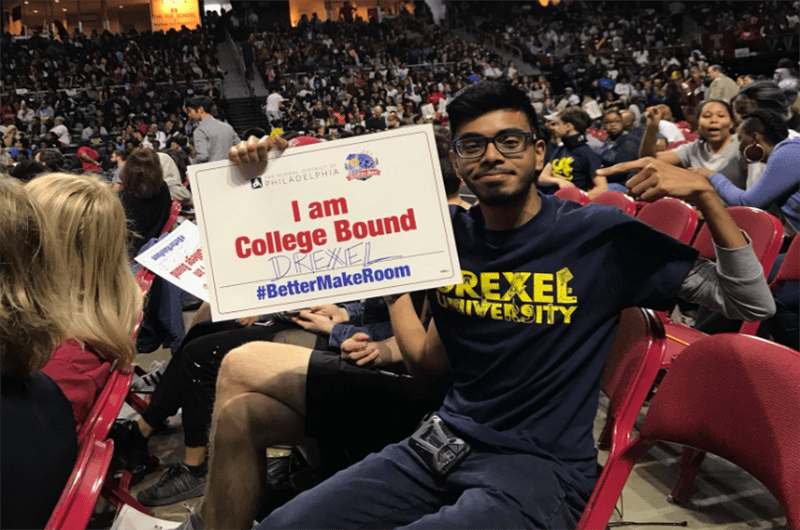Another Year of Record Freshman Enrollment at Drexel

For the second year in a row, Drexel University has accepted an incoming class of freshmen that is already breaking records on campus. This incoming class of freshmen is shaping up to be the most academically talented class in Drexel's history and will be the largest ever enrolled at the University.
More than 3,600 accepted students submitted deposits to Drexel to start as freshmen next fall, representing a 2.5 percent increase over last year’s previous record of more than 3,500 accepted students (which was a 43 percent increase from the 2016 number). These Dragons also boasted higher test scores and GPAs compared with the 2017 and 2016 freshmen classes.
The number of freshmen enrolling this fall is expected to finish at 3,300. This is due to the expected “summer melt” of students who submit a deposit but do not end up enrolling — something that occurs at colleges and universities across the country. Last fall, more than 3,200 Dragons began classes on campus — an increase from the 2016 class of incoming freshmen, which had 2,324 students.
This year’s point-in-time average SAT score is 1283, which is 20 points higher than last year’s average, and the median is 1290, which is 30 points higher than the 2017 median. The average high school GPA for this year’s incoming class of freshmen increased by 0.07 points to 3.72, with the median increasing 0.05 points to 3.73.
The increase in the SAT scores and GPAs of the incoming freshmen and the high retention rate for current students demonstrates that the University is continuing to attract and accept qualified students who will join the ranks of a new generation of “right fit” Dragons and be more likely to remain at the University and ultimately graduate. Drexel implemented this new enrollment strategy in 2015 in an effort to attract students who are a better fit for Drexel’s unique academic model, which includes professional experience through cooperative education. More financial aid has also been given to students in recent years to increase student support and improve retention rates, while the University has also enhanced its academic support and first-year experience, as recently detailed in a DrexelNow article.
“Several years ago, Drexel took the lead in responding to secular changes in national higher education trends, and our ability to exceed our enrollment targets shows our strategy is working,” said Senior Vice President of Enrollment Management and Student Success Randy Deike, PhD. “Even more importantly, the University has made widespread changes that will ensure that our students get the support and opportunities they need to thrive through graduation and beyond. This has been a University-wide effort, and I want to thank the broad Drexel community for the many contributions to our success and the success of our students.”
Drexel’s point-in-time yield rate (yield is the percentage of admitted students who enroll) for fall 2017 was 15.8 percent, which was the highest that the University had seen since 2009. This year, the point-in-time yield rate is 15.6 percent, with the slight decrease thought to be a result of the much stronger academic profile of incoming students. In addition, freshman retention this year is similar to prior years, at about 89 percent. The University is still on track to achieve its goal of a 90 percent one-year retention rate.
The increase in freshmen deposits for the second year in a row comes after the University overhauled its recruitment strategy, increasing the number of visits to connect with potential students at national and international high schools, college fairs and off-campus receptions. In recent years, enrollment officials and individual colleges and schools have also worked to meet with more high school guidance counselors and present clearer literature and communication outreach for families to learn from at home.
This year, about 41.9 percent of the students who submitted deposits hail from Pennsylvania, which is 1.9 percentage points higher than the number of in-state residents last fall. Based on the deposits received, 70.5 percent of the incoming class hails from Pennsylvania, New Jersey, New York and Maryland — the same percentage as the fall 2017 class.
The percentage of international students who submitted deposits is 11.3 percent, which is very similar to the number of international freshmen who came to campus last fall. This is a positive sign for Drexel at a time when many colleges and universities have reported declines in international deposits. The top five countries for international deposits are India, Vietnam, China, Pakistan and Nigeria — the same countries that sent the highest number of international students last fall.
New online student enrollments grew 6 percent in the fiscal year, driven by notable increases in the College of Medicine, School of Education and the Thomas R. Kline School of Law. Graduate new student enrollments were particularly strong, resulting in annual growth of over 17 percent. In preparation for the upcoming fall term, 10 new online programs are being launched, which should help build momentum as Drexel University Online strives to exceed last fall’s successful new student campaign that grew enrollments by nearly 13 percent.
Though the deposits for freshmen are on an incline, the deposits for transfer and on-campus graduate students have dropped slightly from last year’s figures. These declines stem from an increased priority of colleges and universities to recruit transfer students due to freshman enrollment challenges and a nationwide decrease in international graduate student deposits.
University officials caution that while the University’s “right-fit” enrollment strategy continues to show positive momentum, the strategy’s success relies also on the continuation of cost-containment measures that were enacted last year.
In This Article
Drexel News is produced by
University Marketing and Communications.

